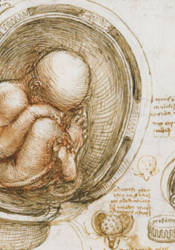Anatomical Manuscript B, Leonardo da Vinci
Anatomical Manuscript B is Leonardo da Vinci’s most comprehensive sketchbook and physical description of the human body. In 1508, he began the manuscript during a dissection of a recently deceased old man who passed in a Florence Hospital. Leonardo stated in the manuscript that, “this old man, a few hours before his death, told me… that he felt nothing wrong with his body other than weakness… and I dissected him to see the cause of so sweet a death.” He attributed the man’s death to lack of blood flow to the heart and a damaged liver. Leonardo continued the manuscript with a dissection of over 30 other cadavers; and with the help of Marcantonio della Torre at the University of Padua, completed it around 1511. Anatomical Manuscript B contains carefully sketched depictions of various organs, muscle groups, skeleton, and much more with highlights including a drawing a developed fetus and astoundingly accurate spinal cord.
Sources:
Royal Collection Trust. “The Centenarian: Anatomical Manuscript B”. Leonardo da Vinci: Anatomist: The Queen’s Gallery, Buckingham Palace. The Royal Collection Trust, 2018. Web. 15 Feb. 2018. Link
Sooke, Alastair. “Leonardo da Vinci’s groundbreaking anatomical sketches”. Art History. British Broadcasting Company, 21 Oct. 2014. Web. 15 Feb, 2018. Link
Image Source:
Image courtesy of The Medievalist.net in article "Exhibition reveals the genius of Leonardo's anatomical work". Link

